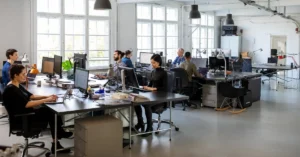Most SMEs would agree that office printers and multifunction devices are an essential part of their daily business operations. However, 22% of small businesses also agree that costs of printing are a major concern for them (Fuji Xerox Printers 2016 Customer Insights Survey). Did you know that printing can account for up to 6% of business revenue? The truth is that many businesses spend more money than they need to on printing purely because they don’t know how to control costs. Unnecessary printing costs can come from personal printing, lack of training or outsourcing printing. In this article, we are going to reveal three simple and effective solutions for reducing your office printing costs.
1. Understand the Total Cost of Ownership (TCO) of your printer
When buying a printer or multifunction device, the initial upfront cost is not always what you should be looking at. The lowest buying price doesn’t mean it’s the most cost-effective solution. When your business is looking to purchase a new printer, you need to look beyond the buying price. Before you invest in a printer, it’s important you look at the overall costs involved with purchasing and running the device. To save money on printing costs, you want to be looking at the total cost of ownership (TCO). Printers with the lowest TCO offer the best value in the long run.
Researching and understanding the TCO when purchasing a new printer or device can help prevent unnecessary financial or productivity loss in the future. There are three key things to take into consideration when calculating a printer’s TCO.
- Physical hardware cost. This is the cost of the printer when you initially buy it.
- Printing costs. These are things such as the cost and capacity of toner cartridges, and the amount of paper your business uses. It also includes whether you’re printing mostly in colour or black and white.
- Running costs. There are a few things to consider when calculating the running cost of your printer. Energy consumption is an important factor to think about. The cost of paper should also be considered when purchasing a printer as different paper is suitable for different printers. Maintenance costs such as servicing, including downtime and productivity loss due to staff fixing the printer and replacing consumables too frequently.
Once you understand what goes in to calculating the TCO of a printer, you can begin looking at the individual needs of your business and how your printer or multifunction device will be used in your organisation. Consider things like:
- Estimated number of pages to be printed each month
- Ratio of colour vs. black and white printing
- How long you plan to use your device (3, 4 or 5 years)
- Size and quality of paper
- Additional features like wireless and secure printing.
After you have gathered the above information, use this handy equation to find out the TCO of your printer.
2. Implement a Managed Print Service (MPS) solution
Managed Print Services (MPS) has the potential to save SMEs a large sum of money, which is why it’s such a popular solution for many businesses. MPS is the outsourcing of maintenance, management and support of your printer to a professional third party for a set per-page price every month. The benefit is that your print costs are known in advance, it’s a cost you can plan and budget for, and one you can factor in to your cash flow requirements.
However, for MPS to actually be beneficial to your business, with the help of your MPS provider you can assess your company’s current output situation. Once you have an accurate picture of total cost of ownership (TCO) for all your printers and copiers, you can then optimise them to provide both short and long-term savings for your business.
The major benefits of MPS
Besides reducing the printing costs of your business, there are a range of other benefits of MPS.
- Reduce your carbon footprint. MPS can help to reduce your company’s carbon footprint by reducing your paper usage.
- Better office productivity. A well-implemented MPS solution can boost office productivity in a few ways. One example is that employees will have less distraction from printers that aren’t working or are out of toner.
- Free up IT resources. One of the biggest cost savings from MPS is a more productive IT department, which is often a company’s most expensive resource. So, instead of using all their time fixing printer issues, your IT team will have time to focus on bigger company issues, such as security.
3. Always use Genuine Toner
Do you sometimes find that your office burns through your cartridges, colours are off and you need to have your device regularly serviced and you’re spending more money on your printer than you thought you would? It may be because you’re using non-genuine toners.
Sourcing cheap consumables is a common tactic businesses use to save money. However, the reality is that non-genuine toners can cost your business much more in the long run. From lower page yield to machine downtime, loss of productivity and damage to your device, non-genuine toners are in fact much more expensive in the long term, and certainly not worth the ‘cheaper’ outlay. Learn more about the benefits of genuine toner here.






